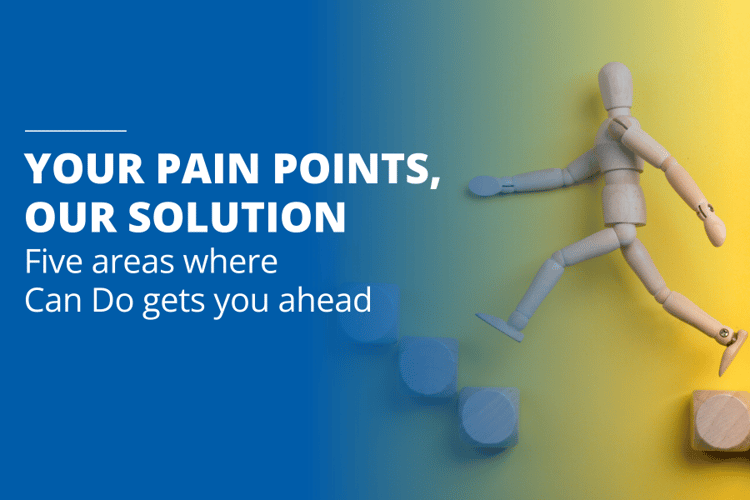
When I present our Can Do project management platform to interested parties, of course I also talk about the "unique selling points" of the software - such as our own AI and special algorithms or the innovative approach to company-wide skills management. However, the focus of the consulting is always on the question "Where is the shoe pinching in project management?"
Over the years, it has become clear that while each company faces its own unique challenges, there is also a great deal of overlap. These can be broken down into five topics, and if you read on, you will certainly notice: Quite a few of the points also belong to the "pain points" in your project management or your company:
Five "problem zones", five solutions
The five overarching themes where there is a need for optimization in almost every company are:
- Resources and Skills
- Portfolio Management
- Artificial Intelligence and Methods
- Controlling & Risk Assessment
- Problems on the part of the users
Let's take a look at this in detail:
Resources & Skills
Resource management is, as we have often stated, the supreme discipline of project management. But it is precisely here that there are often deficits that need to be addressed:
- Employee utilization is unclear and not presented transparently;
(often undocumented) overloads occur. - There is no global medium- and long-term capacity planning.
- Coordination between project and line is complicated and time-consuming.
- New projects and resource allocations are started without prior simulation.
- Vacation planning is disconnected and does not take into account the project load.
- There is no time tracking at the project level.
- In case of short-term capacity problems, expensive external solutions are purchased first.
Can Do addresses all of these issues with its AI-driven resource and skills management: Capacity planning and resource allocation are transparent, cross-project and company-wide. Teams are assembled according to skills and capacities. Project simulations facilitate project planning, and both vacation planning and time tracking are integrated into the PM platform.
Portfolio Management
Small projects, small challenges - big projects, big challenges: Portfolio management brings with it yet another set of completely different issues. These include, among others:
- There is often a lack of real-time overview of ongoing projects.
- Status updates are not automated, but manual.
- There is no simulation of how new projects affect the overall structure of the portfolio.
- Project priorities change frequently and are unclear.
- The depiction of functional dependencies between the individual projects is only diffuse.
This is where it becomes noticeable that Can Do's project management is virtually infinitely scalable: Everything that was said about resource and skills management in the previous chapter applies without restriction to even the most extensive portfolios.
Artificial Intelligence & Methods
While many companies are still wondering whether AI can also be used for project management, Can Do has already been using it successfully for years (and, as of August 2023, is working on the second evolutionary stage of AI, which was developed specifically for the Can Do PM software). This is joined by other technical methods that enable, for example, seamless integration of software already in use. Companies whose project management does not yet rely on AI and such methods must deal with these limitations, among others:
- There is no interface between agile and classic project management.
- There is no comprehensive technical integration with other systems such as SAP® or SalesForce®.
- AI-based methods such as "imprecise planning" or resource allocation according to Watermodel® are not available.
Controlling & Risk Assessment
Having control over a project at all times, correctly assessing any risks and keeping an eye on all eventualities as far as possible during project planning: This is not only difficult, but also almost impossible to manage with conventional project management. Companies that do not yet use Can Do often report these difficulties in the area of controlling and risk assessment:
- Projects are often not completed on time and turn out to be more costly and time-consuming than planned.
- Planning deviations are not quantifiable and do not lead to the necessary learnings.
- Changes to plans set unclear, non-transparent processes in motion.
- Compared to effort and costs, the benefits are often uncertain.
- Short-term project postponements have a negative impact on other projects and disturb stakeholders.
- Manual risk assessments are often made without taking objective risks into account.
Can Do's proprietary software algorithms and AI are also used in these areas. They identify impending project risks and provide clear recommendations for action. They create project simulations with a high degree of informative value and support long-term, project-appropriate resource planning and procurement.
Problems on the part of the users
It is actually quite clear, but unfortunately it is neglected far too often: Every software can only show its advantages and capabilities if it is accepted by the users and they use it gladly and goal-oriented. However, the daily software routine in many PMOs is still far too often quite different: In a heterogeneous environment, project planning with Excel® spreadsheets, data maintenance with other programs and "project management" with notes exist side by side - and get in each other's way more than they complement each other in a meaningful way. In such cases, a "big clean-up" is urgently called for: When switching to the uniform (and user-friendly!) PM platform Can Do, a whole series of obstacles and annoyances in project management are eliminated at the same time, such as:
- Project planning without a digital fact base leads to low acceptance or even mistrust.
- "As a precaution", shadow planning is carried out in parallel in Excel®.
- Because no consistent approach is apparent, planning is ignored and project data entry is unreliable.
- Data maintenance is costly and unloved.
- Data is entered twice or several times in different systems.
- Different planning systems exist, but are implemented in an uncoordinated manner.
Conclusion: one for all
Do you recognize the challenges of your company or your project management in some of the above examples? Then you are not alone: these are exactly the neuralgic points where project and portfolio management repeatedly and in numerous companies gets stuck. The good news is that Can Do can support you in a highly effective way and make your PM fit for a future full of successful projects - in time, in quality & in budget. Would you like to learn more? Arrange your personal Can Do presentation right now! I look forward to demonstrating the right solution for your "pain points"!
Jetzt anmelden - Can Do Newsletter
Ariane Becker is in continual exchange with interested parties from various industries. Her main focus is to bring the right information and suitable experts together and getting directly involved in the use cases and the software.
Why Do Projects Fail? 5 Common Reasons - And How to Avoid Them
Projects are often complex, and even with the best intentions and a competent team, success can elude us. But why do so...
Cost-Cutting - Increasing Efficiency Without Additional Resources
Cost-cutting is currently at the top of the agenda for many companies. In the face of economic uncertainty and rising...
.png?width=200&height=80&name=CanDo%20Logo%20transparent%20(500%20x%20200%20px).png)

